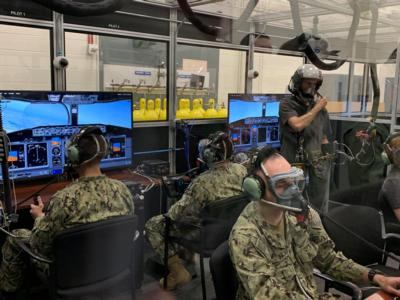Thu, Jun 10, 2021
Former Methods Often Caused Decompression And Barotrauma Sickness
The Naval Aviation Training Systems and Ranges program office (PMA-205) Normobaric Hypoxia Trainer (NHT) team recently designed, delivered, installed, and began support of the NHT at Naval Air Station (NAS) Patuxent River, the first trainer of its kind eliminating common hypoxia training injuries.

The legacy Low Pressure Chamber trainer used in hypoxia training for pilots and aircrew often caused decompression and barotrauma sickness, the leading causal factors for training injuries in the Naval Aviation Survival Training Program (NASTP). The NHT team, made up of an expert group of research engineers and scientists, looking to mitigate those injuries, developed the NHT concept.
“With the critical and innovative work of our NHT team, we no longer need to worry about barotrauma during cold and sinus season that caused trapped gas pain and injury in our fixed wing non-ejection seat aircrew students at the Aviation Survival Training Centers,” said Cmdr. Andy “Lurch” Hayes, NASTP integrated project team lead. “Inside safety observers no longer need to administer nasal decongestants or perform the invasive Politzer maneuver to inflate the middle ear and sinuses by injecting compressed air up one nostril while the other was closed.”
The NHT design not only eliminates the risk of barotrauma and decompression sickness, but it also can simulate high altitude flight while accommodating up to 12 personnel including six aircrew and two pilot/co-pilot teams monitored by two inside observers. Borrowed from the success of students trained on the Reduced Oxygen Breathing Device, the team included flight simulators and controls to add realism and allow aircrew to practice Emergency Procedures (EP) specific to their Naval Air Training and Operating Procedures Standardization aircraft. This is the first time in naval aviation history that fixed wing non-ejection seat pilots are able to practice EPs in a state of hypoxia.
“Gone are the days of patty cake in the chamber to monitor hypoxia symptoms. We are fortunate to have the aviation physiology expertise on our team that creatively developed a training system that allows the aircrew to experience hypoxia in a safe environment while conducting aviation operator tasks,” said Capt. Lisa Sullivan, PMA-205 program manager.
More News
He Attempted To Restart The Engine Three Times. On The Third Restart Attempt, He Noticed That Flames Were Coming Out From The Right Wing Near The Fuel Cap Analysis: The pilot repor>[...]
Make Sure You NEVER Miss A New Story From Aero-News Network Do you ever feel like you never see posts from a certain person or page on Facebook or Instagram? Here’s how you c>[...]
From 2009 (YouTube Edition): Leading Air Show Performers Give Their Best Advice for Newcomers On December 6th through December 9th, the Paris Las Vegas Hotel hosted over 1,500 air >[...]
Aero Linx: NASA ASRS ASRS captures confidential reports, analyzes the resulting aviation safety data, and disseminates vital information to the aviation community. The ASRS is an i>[...]
“For our inaugural Pylon Racing Seminar in Roswell, we were thrilled to certify 60 pilots across our six closed-course pylon race classes. Not only did this year’s PRS >[...]
 NTSB Final Report: Rutan Long-EZ
NTSB Final Report: Rutan Long-EZ ANN FAQ: Turn On Post Notifications
ANN FAQ: Turn On Post Notifications Classic Aero-TV: ICAS Perspectives - Advice for New Air Show Performers
Classic Aero-TV: ICAS Perspectives - Advice for New Air Show Performers ANN's Daily Aero-Linx (06.28.25)
ANN's Daily Aero-Linx (06.28.25) Aero-News: Quote of the Day (06.28.25)
Aero-News: Quote of the Day (06.28.25)



